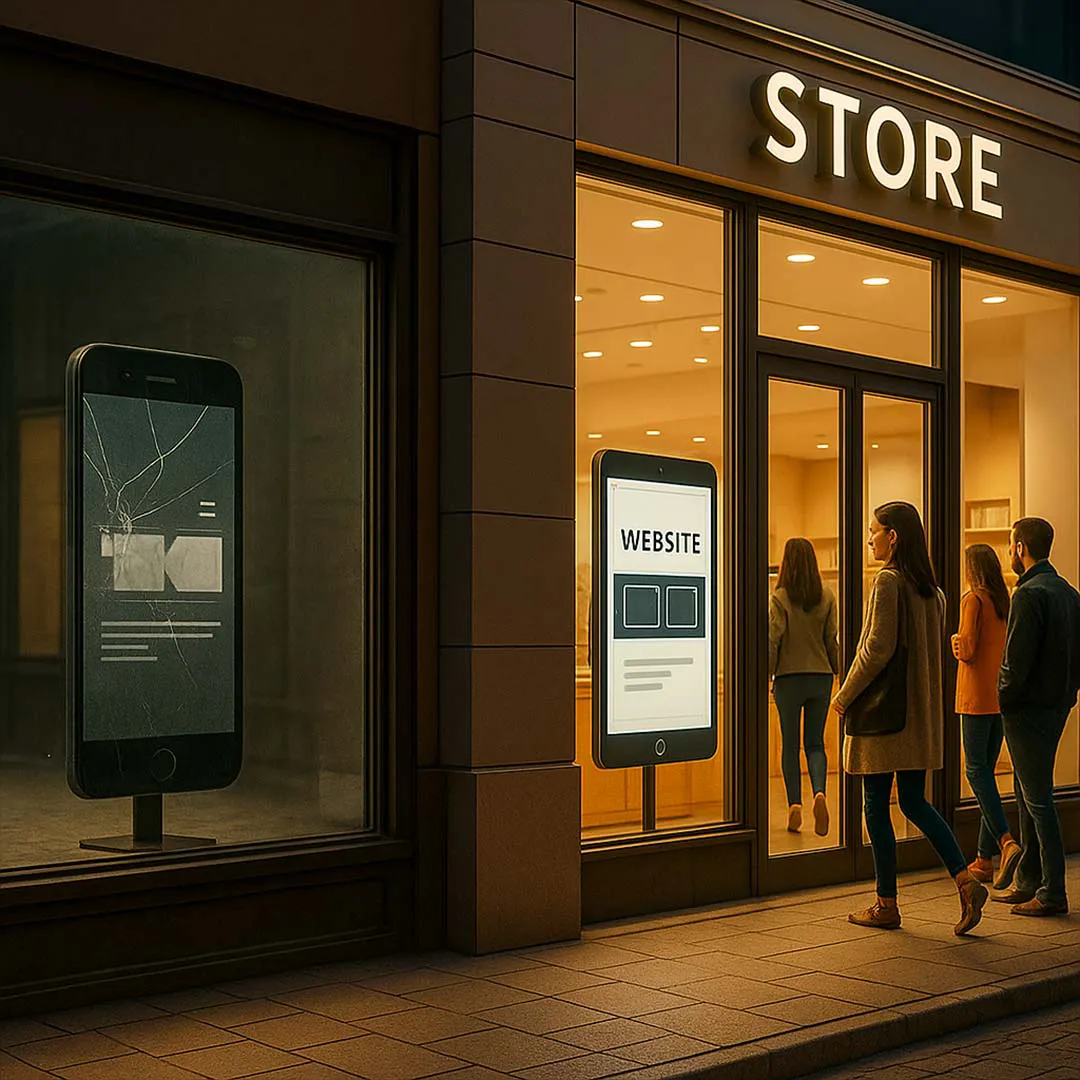
How to go mobile-first: Web design tips that boost traffic
7. November 2025
Mobile-first determines visibility, trust, and conversion in B2B because Google primarily evaluates websites on mobile devices. Learn how you can quickly win over decision-makers and gain more qualified leads with fast loading times, a clear structure, and a strong mobile UX.
Overview
- Mobile-first is crucial because Google indexes mobile content and B2B decision-makers check content on the go first.
- You plan content, navigation, and forms for smartphones first, then expand for desktop.
- This is how you increase visibility, speed, user experience, and leads—and avoid high bounce rates.
More than half of all B2B decision-makers access websites on mobile devices today. You know the situation: you visit an important landing page, it loads slowly, the navigation feels cramped, forms are tedious. You bounce. That’s exactly what happens to your potential customers if your B2B website isn’t mobile-first optimized in 2025.
Mobile-first web design determines visibility, user experience, and conversion rate. Google crawls mobile versions first and automatically ranks pages that perform poorly on mobile lower. Without mobile-first, you lose reach, trust, and revenue.
In this guide, you’ll learn why mobile-first is essential in B2B, how to implement it strategically, and which mistakes to avoid. You’ll receive concrete steps and frameworks to make your website more effective.
What is mobile-first web design?
Mobile-first web design describes a development approach where you design for mobile devices first, then expand to larger screens. You reduce complexity to the essentials to ensure clear user journeys, fast loading times, and intuitive usability. After that, you scale for desktop and larger displays.
Mobile-first is based on the reality that decision-makers search for information on the go and only dive deeper later. You optimize performance, structure, interaction design, and content for mobile use while simultaneously strengthening your results in organic search. This approach differs from responsive design because you don’t just adapt — you actively build with mobile optimization as the priority.
Why is mobile-first web design important?
Mobile-first web design increases visibility, speed, and usability. Google ranks websites based on their mobile version and penalizes pages that perform poorly on the go. In the B2B sector, research often begins on mobile devices, even if contracts are finalized on desktop. Mobile-optimized websites improve lead quality, enhance campaign performance, and reduce bounce rates.
A better mobile UX shortens the path to the contact form, appointment calendar, or quote request. Mobile-first ensures every interaction is clear, fast, and goal-oriented. You win decision-makers earlier in the funnel, position yourself as innovative, and signal digital competence. Without mobile-first, you risk visibility, conversion, and brand trust.
How mobile-first web design works in practice
Mobile-first starts with prioritization: content, functions, and structure follow a clear logic. You begin with the smallest screen size and plan navigation, CTAs, content, and forms for mobile first. After that, you develop tablet and desktop versions. This method creates clarity and efficiency. You use progressive enhancement: mobile forms the foundation, desktop provides extras and depth.
Step-by-step procedure
- Define target groups and user paths
- Sketch mobile wireframes and navigation
- Use clear CTAs and easily accessible buttons
- Prioritize content and remove distractions
- Use high-performance code, compressed media, and lazy loading.
- Develop modular components and scalable layouts
- Test regularly on real devices and in all browsers
- Only add desktop features after achieving mobile perfection
Resources
Tools:
- Google Lighthouse
- PageSpeed Insights
- Hotjar
- BrowserStack
- Figma
- Webflow
- WordPress with a high-performance theme
Methods:
- Atomic design
- Component-based development
- Mobile UX testing
- Core Web Vitals monitoring
Examples from B2B web design:
- Mobile-optimized inquiry form
- narrow product feature boxes
- Touch-friendly price comparisons
- mobile-friendly case studies
- Short hero messages with clear appointment requests
| Aspect | Mobile-First | Desktop-First |
|---|---|---|
| Indexation | optimized for Google | ranking risk |
| Loading times | fast | higher data demand |
| User starting point | on the way | office environment |
| Complexity | main focus | more details |
| Lead potential | strong on first contact | strong at closing |
Opportunities and risks of mobile-first web design
Mobile-first offers clear advantages: better rankings, faster loading times, more mobile leads, and a modern brand presence. Risks only arise if desktop features are neglected. A pure mobile focus without desktop enhancement weakens deeper offer phases. Successful B2B websites combine both: mobile for first contact and quick information, desktop for tools, presentations, and contract details.
Short answers to typical questions
How does mobile-first affect SEO?
Mobile-first improves rankings through speed and mobile UX.
When is desktop more important?
For complex product tools or configurators.
Does everyone need B2B mobile-first?
Yes, because mobile research is standard today.
How do you avoid risks?
Build a mobile base and expand it for the desktop.
The future of mobile-first web design
Die Zukunft verbindet Mobile-First, AI personalization und intuitive navigation. Systems dynamically optimize layouts, content adapts to user intent, and AI delivers personalized funnels. Voice control, AI heatmaps, and data-driven layout automation are growing. Websites evolve into adaptive, intelligent touchpoints. Your task is to implement Mobile-First today and then introduce AI usage and data personalization.
Conclusion
Mobile-First web design determines whether you reach, convince, and convert B2B companies into clients. You gain visibility, conversions, and trust. Build for mobile first, expand for desktop, and test consistently. If you want sustainable leads, start your customer journey on the smartphone. Would you like to check how well your website is implemented Mobile-First? Let’s analyze your performance and create an action plan.
FAQs
Our blog
Latest news
With our blog, you are always close to our work, our current projects and the latest trends and developments in web and print.
Any questions?





